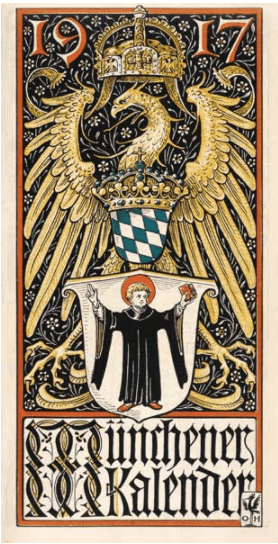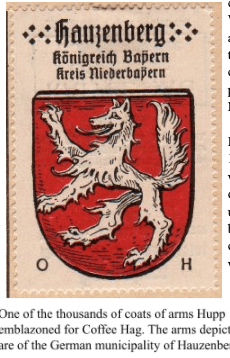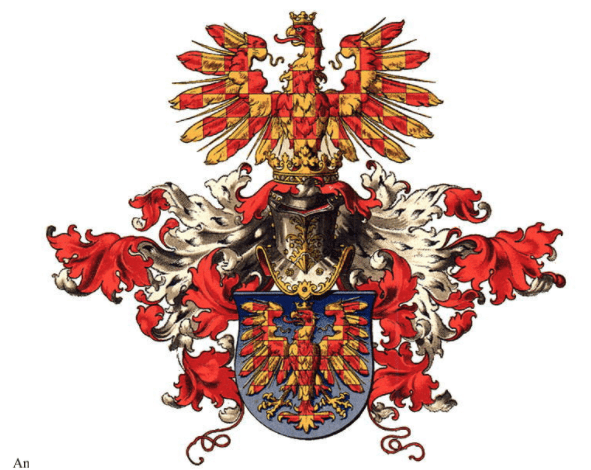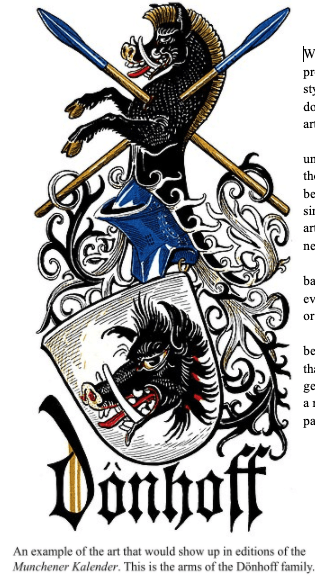The Art Of Otto Hupp
(which devolves into Rambling About Heraldic Art)
By Ziyi Lu
Otto Hupp (1859-1949) was a German artist who specialized in coats of arms and typography. His most well-known heraldic art (or, if we’re going to be honest, the most influential to me) is the Mṻnchener Kalender (Munich calendar) that he published from 1885 to 1936. Some of his other work includes over 4,000 coats of arms he painted for the coffee company Coffee Hag.
to be honest, the most influential to me) is the Mṻnchener Kalender (Munich calendar) that he published from 1885 to 1936. Some of his other work includes over 4,000 coats of arms he painted for the coffee company Coffee Hag.
Heraldic art is a curious niche in the art world, and to understand it, one must have a basic understanding of the discipline of heraldry. Originating in the 12th century, heraldry is a broad term that encompasses the designing and regulation of coats of arms. Coats of arms were originally important on the battlefield, as unique designs painted on shields allowed soldiers to distinguish between friends and foes. While heraldry obviously doesn’t serve that purpose anymore, coats of arms are still in use to this day, representative of entities ranging from countries to towns to corporations to people. Those considerations influence the overall style of heraldic art even now; coats of arms should still be identifiable from a distance and rendered distinctly enough to be told apart from each other easily.
With that in mind, heraldic artists will pay special attention to try and make each element of the shield as visible as possible. Animals will often be stylized to look like how artists in the Middle Ages may have depicted them, instead of being realistic.
I decided to write about Hupp because of my interest in heraldic art, and I won’t deny that may make this writing a little hard to follow along.
However, it doesn’t take a heraldic enthusiast’s eye to appreciate Hupp’s work. His stylized renditions of beasts such as eagles and lions are detailed and exaggerated, their proportions changed from real life to fill up the shield they are emblazoned on. The bold, bright colors of the beasts and shields were achieved by the use of relief printing, and the use of one color per layer allowed Hupp to achieve large fields of solid color, which pushed a style reminiscent of something you’d see on a poster. While distinct, his style retains an old-fashioned vibe that feels inspired by older German heraldic art, such as the work of Hugo Gerard Ströhl. His art style is visibly moresimplified, using bolder lines and solid colors.


Unfortunately, his art shouldn’t be an excuse to dismiss his dubious ties to the Nazi Party. The 1935 edition of his Kalender features on its cover an eagle with “Heil Hitler” written on its wings. It may feel comforting to brush it away as Hupp just trying to appease the current government, but one must consider that Hupp was funding the publication of his own calendars at the time that edition of the Kalender was published. To appreciate an artist’s art, we must come to terms that that artist may not have been the “good person” that we come to think of them as and denounce them for their wrongdoings.
Some comfort can be found in the fact that Hupp’s work entered the public domain in 2020, and one can do whatever they’d like with his work as they please without any legal repercussions. Nothing you do with his work will be supporting him.
 With that stated, I can’t deny the influence that Hupp’s work has had on my style of heraldic art, to the point of pastiche where I deliberately try to imitate his style. Pastiche is widespread in heraldic art. While many artists develop a modern style, an equally prominent number of artists are content with imitating the styles of past heraldic art that’s long gone into the public domain. That, of course, does not warrant decrying such artists as mere imitators.
With that stated, I can’t deny the influence that Hupp’s work has had on my style of heraldic art, to the point of pastiche where I deliberately try to imitate his style. Pastiche is widespread in heraldic art. While many artists develop a modern style, an equally prominent number of artists are content with imitating the styles of past heraldic art that’s long gone into the public domain. That, of course, does not warrant decrying such artists as mere imitators.
Heraldic art is deeply rooted in tradition, which is understandable since the practice of heraldry is almost a thousand years old. Modern innovations are few and far between, and the ones that do catch on are often denounced or simply fade into obscurity. I feel this may be a reason why artists are more likely to imitate or draw inspiration from a new style instead of developing their own.
I’m not going to claim that new innovations are good or bad. Personally, I believe that heraldic art will inevitably evolve and change over the centuries, and people may like it or dislike it.
I’d really like to see a contemporary take on heraldic art because I want to see how people with a different perspective than heraldic artists would interpret it. I hope heraldry, in general, gets some more attention in the art world because it’s a rather obscure art form where a lot of misinformation is passed around.
Sources Cited
“Otto Hupp.” Wikipedia, en.wikipedia.org/wiki/Otto_Hupp. Accessed 26 July 2021.
“Otto Hupp – Heraldry of the World.” Heraldry of the World, www.heraldry-wiki.com/heraldrywiki/wiki/Otto_Hupp. Accessed 26 July 2021.
“Münchener Kalender.” (Heraldic Collector’s Items), www.heraldry-wiki.com/heraldrywiki/wiki/M%C3%BCnchener_Kalender.